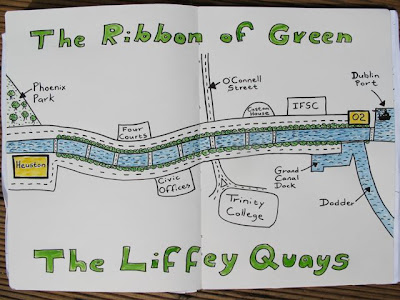FERGAL McCARTHY, Irish Times Saturday November 24
COMMENT: Dublin City Council is examining how better to use the city quays. But will it be ambitious enough?
The Liffey is arguably Dublin’s greatest asset: it’s the reason Viking settlers made their homes here and it is the backbone of the city. It has been a source of economic activity for centuries and should continue to be so.
The Millenium footbridge, the opening of the boardwalk along the north quays, the completion of the port tunnel and the ban on heavy goods vehicles have improved the area considerably.
I was thrilled to hear that Dublin City Council and the National Transport Authority is undertaking a study to rearrange the traffic on the quays to maximise space for cyclists and pedestrians, while maintaining priority for buses. It will look at the Liffey corridor from the Phoenix Park to the O2. If this plan goes ahead Dublin will take its place among the international cities that have introduced measures to curb car use. It is also a huge opportunity to re-establish the river as the centre of the city.
Currently the quays are viewed as a facility for moving people around the city, but the Liffey could easily become a destination in itself. Dublin is a coastal city with a river flowing through its centre. Whenever we capitalise on these natural assets the city works so much better. Last August more than a million people gathered around the river over the course of the Tall Ships Race. In my opinion it was one of the best events to take place in the city.
It is time to redevelop the Liffey quays as a world-class urban park. Most of the roads along the quays have three lanes. If at least one lane at either side of the Liffey were closed to traffic, the space could be used for wider footpaths and to create a linear park between Heuston Station and the O2. This is possible while retaining space for traffic, buses and bikes.
Such a park would need an overarching identity, with uniform lighting, bespoke street furniture and planting. Once the council’s study is complete, an international architectural competition could be launched to find a signature design that unifies the whole area along the quays, tying together the new footpaths, the boardwalks and the already widened campshires in the docklands.
Local forums could be convened for people to contribute their ideas about what they would like included in the park. Dubliners would be intrinsic to the success of the park, by both populating it and helping to run it. It is crucial that any new development have a dedicated trust to curate these activities and oversees maintenance, gardening, litter management, security and fundraising.
My interest in the river stems from being an artist. I make films about swimming in it, I have installed giant Monopoly houses on it and for a week last year I lived on a desert island that was moored in the docklands.
An 8km linear park would offer a wide range of walking and jogging routes. Food carts could be dotted at pitches along the quays and space created for markets with permanent metal tents. Playgrounds, skateparks and a daily roster of changing outdoor performances and events could also feature.
Now that we can no longer afford to hop on a flight to Spain every weekend it seems that our interest in the city has reignited. The park would provide an opportunity to harness this new energy by inviting people to volunteer and use their skills to re-present the city and make the quays work.
A reimagined Liffey could kick-start a renaissance of Dublin and make it a safer environment. It could be marketed as the first port of call for every visitor to the city. It would become a desirable location to live, work and set up business.
Many cities are researching plans for statement urban parks that would improve their centres and attract international attention, tourist revenue and local investment. Dublin already has a very beautiful, world-class attraction. The Liffey just needs a better frame










































